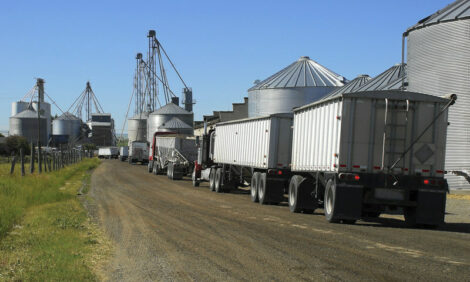



Pork Commentary: The Swine Market is Bad
CANADA - This week's North American Pork Commentary from Jim Long.Every week we look for positive things to give us hope that the financial losses we have been experiencing are coming to an end soon. It’s a challenge. It is the proverbial "Little boy looking for the Pony in the Manure Pile". Optimistic but hammered by the everyday reality of gushing financial losses.
We hear stories daily of producers giving up – either running out of cash (capital), or desire (courage). The attrition is daunting. There is no easy exit strategy. Good sow units are being offered for sale at less than $500 per sow when you take off land value. We are in an industry where not only have there been cash losses of $5 billion over the last 2 years, but we face an infrastructure market value loss of almost equal amounts. The truth is we are all marooned. We stay and fight or we exit with nothing but our memories of what was once a good business. There are few options.
Pork powerhouses
Last week successful farming released its annual list of pork powerhouses. It showed a marked decrease. The top 25 US powerhouses have dropped year over year 200,899 sows. In Canada the 5 largest two years ago had 280,395. The same 5 companies in 2009 had decreased to 153,000. One of the five two years ago Stomp Farms had 40,000, now they are out of business.
The grim reality of the huge financial losses that our industry has encountered has not missed the powerhouses. There has been no silver bullet. From what we understand there are further reductions at some of the larger systems. The ability to maintain cash flow is a challenge for us all. Week upon week of $30 per head losses is draining $70 million a week from our industry. It’s not hard to do the arithmetic. The number of sows of each powerhouse and how many hogs they should produce to come up with how bad this is.
| US Pork Powerhouse 2009 | Company Headquarters | ||
|---|---|---|---|
| 2009 | 2009 | 2008 | |
| 1 | Smithfield Foods/Smithmold,VA. | 922,251 | 1,020,000 |
| 2 | Triumph Foods/St. Joseph, MO. | 371,500 | 396,000 |
| 3 | Seaboard Foods/Shawnee Mission,KS. | 213,800 | 213,800 |
| 4 | Iowa Select Farms/Iowa Falls,IA. | 152,900 | 160,000 |
| 5 | The Pipestone System/Pipestone, MN. | 132,000 | 143,600 |
| 6 | The Maschhoffs/Calyle, IL. | 130,000 | 130,000 |
| 7 | Prostage Farms/Clinton, NC. | 125,000 | 140,000 |
| 8 | Cargill/Minneapolis, MN | 116,000 | 116,000 |
| 9 | The Carthage System/Carthage, IL. | 85,000 | 90,250 |
| 10 | AVMC Management Services/Audubon,IA | 77,000 | 82,000 |
| 11 | Maxwell Foods/Goldsboro, NC. | 69,000 | 73,000 |
| 12 | Hormel Foods/Austin, MN. | 54,000 | 54,000 |
| 13 | Progressive Swine Technology/Columbus, NE | 53,200 | 55,200 |
| 14 | Tyson Foods/Springdale, AR. | 52,000 | 70,000 |
| 15 | Country View Family Farms/Hathold, PA. | 46,500 | 43,700 |
| 16 | Nebraska Pork Partnors/Columbus, NE. | 44,500 | 50,000 |
| 17 | Wakefield Pork/Gaylord, MN. | 40,500 | 41,000 |
| 18 | Holden Farms/Northfield, MN. | 40,000 | 40,000 |
| 19 | Texas Farm/Perryton, TX | 40,000 | 39,000 |
| 20 | TriOak Foods/Oakville, IA. | 35,000 | 35,000 |
| 21 | Schwartz Farms/Sleepy Eye, MN. | 30,000 | 30,000 |
| 22 | Coharlo Farms/Clinton, NC. | 29,000 | 31,700 |
| 23 | M2P2/Aimes, IA. | 27,500 | 30,000 |
| 24 | Swine Graphica Enterprises/Webster City, IA. | 24,100 | 24,100 |
| 25 | Coastal Plains Pork/Murrells, NC. | 24,000 | 27,000 |
| TOTAL Loans of 200,899 sows | 2,934,251 | 3,135,150 | |
| 2009 | Western Canada Pork Powerhouses | 2009 | 2008 |
| 1 | Hytek, LaBroquerie, MB | 58,000 | 60,000 |
| 2 | Big Sky Farms, Humboldt, SK | 42,000 | 47,800 |
| 3 | Maple Leaf Agri - Farms, Landmark, MB | 35,000 | 44,000 |
| 4 | The Puratone Corporation, Niverville, MB | 28,000 | 40,000 |
| 5 | Sunterra Farms, LeRoy, SK. | 13,000 | 13,000 |
| TOTAL Loans of 28,800 sows | 176,000 | 204,800 | |
230,000 fewer sows - Canada – USA in the pork powerhouses year over year will definitely decrease future hog supply.
Pork Farm to Retail
USA Pork farm to retail price spread was $2.302 pounds, in August 2008 it was $1.939 pounds. Thank you very much Mr. Retailer for filling your pockets while farmers are losing their farms. Someone asked us last week why are retailers taking such a margin? Our answer: "Because they can." The one positive is pork is moving and not being put in storage despite retail pork prices that are far from discounted. This indicates descent retail demand. As pork supply diminishes, this should be positive for hog prices.
Feeder Pigs and Early Weans
The cash prices for early weans and feeder pigs have come off the floor last week. They increased, according to the USDA report $4 - $7 each. Seasonality is working in favor of continued price appreciation. We expect cash early – weans to exceed $30 within four weeks. Lower feed prices, stronger lean hog futures and the reality of more finisher barns then there are pigs all play into price appreciation.
Canada
- Cull sow shipments to the USA from Canada since the first of July are 37,000 higher than a year ago. This is a reflection of liquidation ongoing in Canada.
- Small pig shipments from Canada the last 8 weeks have averaged 90,000 per week. The week of 22 August at 85,000 was the smallest week since the winter of 2003. In 2008, Canada averaged 141,000 per week the decline to 90,000 the last weeks is a result of liquidation and some pigs staying in Canada. The end result is there are fewer pigs for US finisher barns and packers. These numbers are fortunately quite accurate as they are based on USA government import numbers. Fewer pigs will be price enhancing.
Summary
- This coming week we will be visiting Mexico and attending the Mexican Pork Exposition. We will give a report next week.
- This Friday the USDA will release the 1 September Hogs and Pigs Report. Let’s hope it shows significant herd liquidation.









